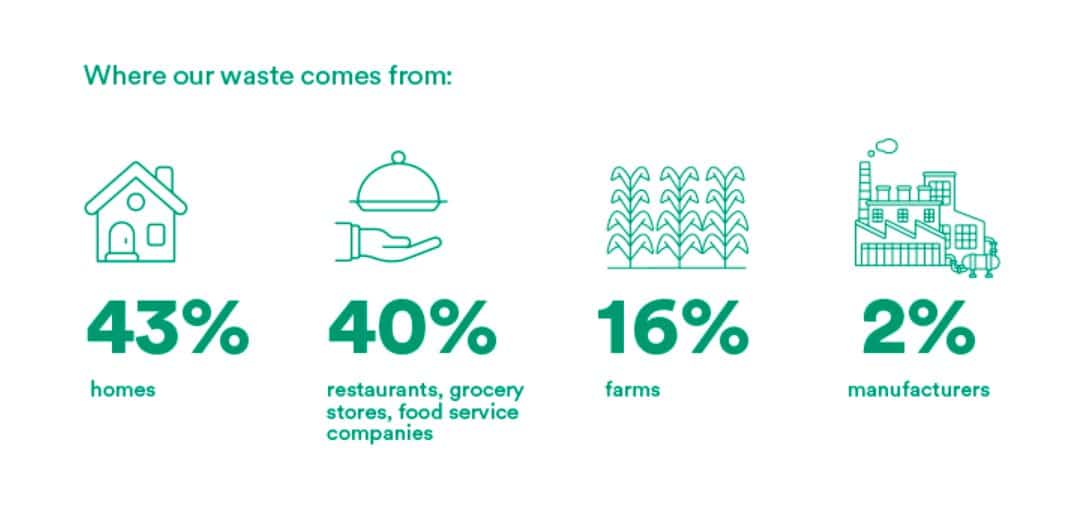Shockingly, one-third of all food produced for human consumption is wasted each year and this alone is responsible for 8% of global greenhouse gas emissions. The US is the third-highest country in the world for food waste per capita, behind China and India. In 2020, Americans threw away more food than the citizens of the UK, Germany, France, Italy, and Sweden combined. We take a look at food waste statistics in America to understand the drivers and the detrimental impact it has on the environment and food security.
—
What’s Wrong With the Modern Supply Chain?
Our current methods of industrial food production are wreaking havoc on the environment while failing to provide the agricultural yields necessary to sustain the growing global population, which is expected to hit 9.8 billion by 2050.
The issues posed by the rampant use of fertilisers, pesticides and herbicides, along with the depletion of aquifer water sources, overgrazing and loss of topsoil have been widely analysed and clearly lead to the conclusion that farming practices must change.
Moreover, despite the enormous quantities of food produced to feed the global population, over 800 million people worldwide still suffer from severe malnutrition.
Next to food production, another pressing and pervasive environmental issue of our lifetime is food waste. Shockingly enough, while huge parts of the world bear the brunt of food insecurity, one-third of all the food intended for human consumption – valued at roughly US$1 trillion – is wasted or lost each year. This would be enough to feed 3 billion people. Wasting so much food also means that nearly one-quarter of all the water used to produce it is wasted, an amount that could be used by 9 billion people at around 200 litres per person per day.
10 Food Waste Statistics in America
1. America Generates Nearly 103 Million Tons of Food Waste A Year
While the world wastes almost 1.4 billion tons of food each year, the US alone throws away over one-third of the food it produces. Food waste is the single most common material landfilled and incinerated in the United States, comprising 24 and 22% of landfilled and combusted municipal solid waste, respectively, according to the Environmental Protection Agency (EPA). All this wasted food would be enough to provide nearly 130 billion meals.
Food waste in America has skyrocketed in recent years, tripling in just five decades, and it is now estimated to be 30-40% of its entire food supply. On a daily basis, each American discards on average 0.5kg (one pound) of food.
2. The Annual Food Waste in America is Worth At Least $161bn
The amount of food discarded each year in the US has an approximate value of between USD$161 billion and $218 billion. The average American family-of-four wastes USD$1,500 of food yearly, with the bulk of this financial stress falling on consumers who pay higher prices than those at the sourcing or wholesale stages.
You might also like: 25 Shocking Facts About Food Waste
3. 21-33% of Water Used Across US Farms is Wasted
While food waste occurs across all sectors of the supply chain, most are discarded even before it reaches manufacturing and grocery stores. Food loss at the farm level depends on many uncontrollable variables, including the type and quality of the crop, market price, and consumer demand. When the latter is too low, farmers often plough the crops back into the earth and take a loss before harvesting and packing up food to enter the supply chain. While this can be good for the environment, as the crop that goes back will help produce better soil for future harvests, the unconsumed food will inevitably be wasted, ending up in landfills where it will release huge amounts of greenhouse gases.
Furthermore, growing crops requires extensive amounts of water, which will just be wasted if the food is not consumed. In the US, agriculture alone is responsible for 80% of all water consumed, and between 21% and 33% of it is wasted every year.

Figure 1: Food Waste Across the Supply Chain
4. Food Waste in the US Is Equivalent to the Greenhouse Emissions of 37 Million Cars
The environmental impact of food waste cannot be understated. Disposed food in landfills emits methane, a greenhouse gas 28-36 times more potent than the carbon dioxide emitted by most vehicles. Indeed, landfills are the third-largest industrial emitter of methane. According to the Food and Agriculture Organization (FAO), food waste represents 8% of total global greenhouse gases released into the atmosphere. In the US, organic waste alone accounts for the largest amount of methane emissions and the amount of toxic gases deriving from it is equivalent to the one generated by 37 million cars or more than 42 coal-fired power plants.

Figure 2: Environmental Impacts of Food Waste in America
5. Over 240 Million Slices of Bread Are Chucked Away Every Year
The most wasted food type in the US is bread, with 38% of all grain products lost every year across the country. It is followed by milk – with 5.9 million glasses, or nearly 20% of the total amount produced, poured down the sink – and potatoes, 5.8 million of which are discarded each year.
Americans throw away huge amounts of fresh produce as well: more than half of all fruit and vegetables grown in the country are wasted. They are mostly lost during production, while 12% are thrown away at the retail level due to aesthetic standards – emphasising appearance over their functionality – and 28% at the consumer level. Half of all produce is thrown away by consumers because it is deemed too “ugly” to eat, amounting to 60 million tons of fruit and vegetables every year.
You might also like: Solutions to Food Waste
6. 35% of Edible Turkey Meat Ends Up in Garbage on Thanksgiving
Especially during festivities, US households waste enormous quantities of food. The United States Department of Agriculture estimates that the amount of discarded food in the country increases by 25% during the holidays, due to unsold supplies at supermarkets as well as uneaten leftovers. During Thanksgiving, one of America’s most celebrated holidays, approximately 35% of edible turkey meat, equivalent to 93 million kilograms (204 million pounds), ends up in the garbage.
7. 1 in 6 Americans Is Food Insecure
Shockingly enough, while almost 40% of the country’s food is thrown away each year, more than 54 million Americans – 18 million of which are children – were food insecure in 2020, according to data from Feeding America. These numbers represent a huge increase from pre-pandemic levels, when 37 million people and 11 million children were considered food insecure, and are expected to rise further in the coming years.
Like everywhere else in the world, the food crisis in the US is expected to hit the most vulnerable groups, including low-income people, children, the elderly, and immigrants, further exacerbating the already glaring disparities the country has been dealing with for a long time.
8. Food Waste Accounts for 24.1% of All Municipal Solid Waste
Every year, the average American throws away nearly 100 kilograms (219 pounds) of food. That is the equivalent of more than 650 apples that end up right in the garbage. Food waste is the number one material incinerated in the US and it takes up more space in the country’s landfills than anything else, accounting for 24.1% of all municipal solid waste (MSW).
9. More Than 60% of All Food Waste is Produced on the Commercial Level
Food goes to waste at every stage of food production and distribution, from farmers to packers and shippers, from manufacturers to retailers, and even households. 43% – or about 21 million tonnes (42 billion pounds) – of all food produced in America is wasted in homes. A similar quantity is lost at the retail level, from restaurants to grocery stores. On the other side, the food lost at the commercial level – which comprises manufacturers, retailers, and farmers – contributes to about 61% of all food waste, nearly 33 million tonnes (66 billion pounds) every year.

Figure 3: Origin of Food Waste in America
10. More Than 80% of Americans Throw Away Food Because They Misunderstand Expiration Labels
Surprisingly, one of the most common reasons why American people discard such large quantities of food has to do with the expiration date. More than 80% of perfectly good food is thrown away because consumers misinterpret the date label on the packet. These are often accompanied by sentences such as “sell by” and “best if used by” that are not federally regulated and only serve as a manufacturer’s suggestion for peak quality. However, research conducted in the UK suggests that standardising food date labelling and efforts to raise awareness among the public about its meaning could reduce household food waste by as much as 20%.
You might also like: 8 Shocking Plastic Pollution Statistics to Know About




















